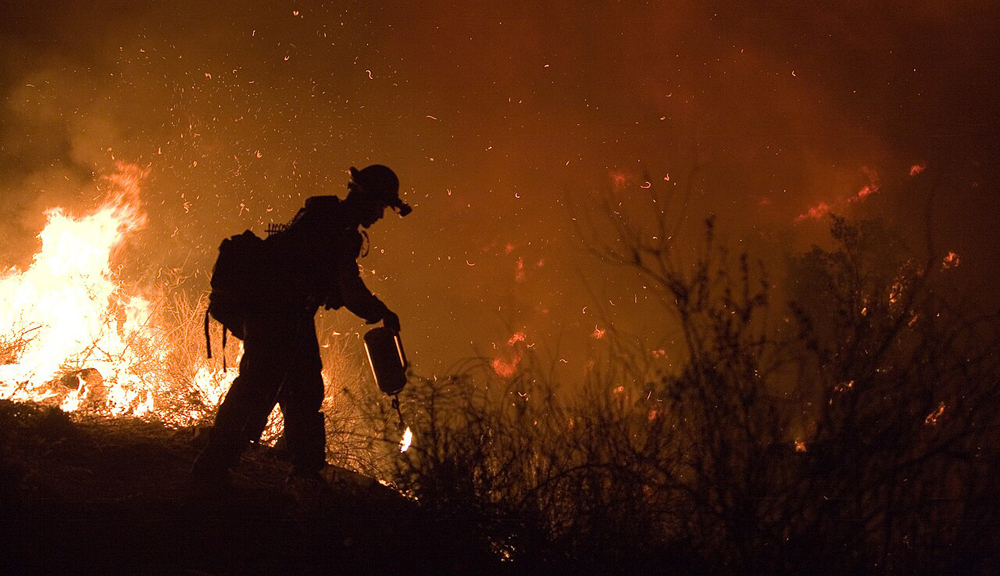Simultaneous large wildfires will increase in Western U.S.
Trend threatens to stretch firefighting resources
Oct 4, 2023 - by David Hosansky
Oct 4, 2023 - by David Hosansky

Northern California fire crews set fire back burn to stop the Poomacha fire from advancing westward (FEMA photo by Andrea Booher).
Simultaneous outbreaks of large wildfires will become more frequent in the Western United States this century as the climate warms, putting major strains on efforts to fight fires, new research shows.
The new study, led by scientists at the National Center for Atmospheric Research (NCAR), focused on wildfires of 1,000 acres or larger. It found that wildfire seasons in which several such blazes burn concurrently will become more common, with the most severe seasons becoming at least twice as frequent by the end of this century.
The research was funded by the U.S. National Science Foundation, which is NCAR’s sponsor, and by the U.S. Department of Energy.
“Higher temperatures and drier conditions will greatly increase the risk of simultaneous wildfires throughout the West,” said NCAR scientist Seth McGinnis, the lead author of the study. “The worst seasons for simultaneous fires are the ones that are going to increase the most in the future.”
While other research has focused on the risk of more frequent and larger fires in a changing climate, the study tackles the problem from a different angle: what is the impact of climate change on fires that burn at the same time?
This is a critical question because simultaneous wildfires generally require more firefighting resources than a single large blaze. Multiple fires have more perimeter for firefighters to contain than an individual fire that burns the same area, and firefighting agencies in different regions cannot share their resources if they are facing a number of major fires burning at the same time.
“Simultaneous fires are a bigger challenge to manage than a number of fires burning one after another,” McGinnis said. “When fires are burning simultaneously, they put more strain on resources.”
The study appeared in the International Journal of Wildland Fire. It was co-authored by scientists from the University of Washington and the Oak Ridge Institute for Science and Education.
The number of large wildfires and the size of burned areas has increased in recent decades in the Western United States, with previous research showing that climate change is at least partly responsible. Since it is more expensive to fight multiple fires than concentrating resources on a single large blaze, McGinnis and his co-authors wanted to determine the future risk of simultaneous fires, addressing the issue in a way that would be most useful for firefighting operations.
The scientists began their analysis by drawing on observations of fires that burned in recent decades across the Western United States, dividing the blazes into regions, known as Geographic Area Coordination Centers, that are used for many fire management decisions. They correlated the fires with observations of atmospheric conditions, including temperature, precipitation, humidity, and surface winds.
The research team then simulated how those conditions will change as the climate warms this century. To do so, they turned to a set of advanced regional and global climate models, including simulations from the NCAR-Wyoming Supercomputing Center. By applying statistical techniques to the resulting simulations, the scientists were able to infer the risk of simultaneous wildfires in Geographic Area Coordination Centers across the West.
The results showed a steady increase in simultaneous fires across all regions of the West throughout this century, with more blazes burning in both relatively moderate and severe seasons. The trend was particularly pronounced for the most severe wildfire seasons — those that currently occur only every 10 years on average. In the future, such seasons may be expected to occur at least twice as often, and up to nearly five times per decade in the northern Rocky Mountains, which was the most affected region.
In addition, as hot and dry conditions become more conducive for wildfires, the peak seasons for simultaneous blazes in various regions will become as much as several weeks longer by the end of the century. This can be critically important for firefighting, since crews and equipment are often moved around the country (or even between the United States and other nations, such as Australia) to fight fires as different regions undergo their own peak seasons.
The study assumed that society would emit high amounts of greenhouse gases into the atmosphere in the future, a scenario known as RCP 8.5. However, even if society were to reduce greenhouse gas emissions, the authors said that would make little difference through mid-century, which is about as far out as policy makers would plan for.
McGinnis said decision-makers can take steps to manage the future risk and impact of simultaneous fires. These range from thinning forests and conducting prescribed burns to increasing firefighting crews and equipment. Such policies, however, can take a number of years to implement, and the strain on resources created by simultaneous fires can affect the ability to conduct prescribed burns and pursue other preventative action.
“We designed this study to be operationally relevant,” McGinnis said. “The findings about long-term trends can be useful to policy makers to inform their decisions on what to do on longer-term policy questions.”